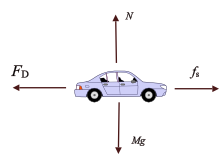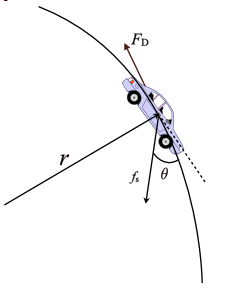
Concept explainers
(a)
To Find:The force of static friction exerted on the car by the runway surface.
The minimum coefficient of static friction necessary for the car to sustain this speed.
(a)
Answer to Problem 90P
Explanation of Solution
Given Information:
Mass of the car,
Air drag on the car,
Speed of the car,
Formula Used:
Newton’s second law:
Calculation:
The following is the free body diagram of the car as the car travels on the runway.

Assume the mass of the car as
Convert the units of the speed of the car from
Speed of the car,
Since, the car is moving with constant velocity, the acceleration of the car is zero.
Net force acting on the car along z axis,
Substitute
Thus, the required static frictional force on the car is
Net force acting on the car along
Rewrite equation
Here
Substitute
Conclusion:
Thus, the required coefficient of static frictional force is
(b)
To Find: The minimum coefficient of static friction necessary for the car to hold the last radius of curvature without skidding.
(b)
Answer to Problem 90P
The radius of the curve at
The radius of the curve at
The required coefficient of friction for the car without skidding is
Explanation of Solution
Given Information:
Mass of the car,
Air drag on the car,
Speed of the car,
Formula Used:
Newton’s second law:
Frictional force
Calculation:
The following is a free body diagram of the car on a circular path.

In the above figure,
Apply Newton’s second law to the motion of the car and calculate the net force acting on the car
The radial force acting on the car along x-axis.
Here,
The tangential force acting on the car along x-axis.
Divide equation
Rearrange this equation for
Substitute
Thus, the radius of the curve at
Similarly, use equation
Substitute
Thus, the radius of the curve at
Calculate the minimum coefficient of friction required for the car to hold at radius
Substitute
Conclusion:
Thus, the required coefficient of friction for the car without skidding is
Want to see more full solutions like this?
Chapter 5 Solutions
PHYSICS F/SCIEN.+ENGRS. W/SAPLING >IC<
- A 9.08 kg mass is released from rest while on and incline of 58.65 degrees. If the coefficient of kinetic friction is 0.301, what is the magnitude of the acceleration of the mass?arrow_forwardWith the coefficient of static friction between the floor of a truck and a box resting on given, if the truck has an initial velocity of Vi , what is the least distance in which the truck can stop if the box is never to slide?arrow_forwardThe 300-N block in the figure is at rest on the roughhorizontal plane before the force P is applied at t=0.The magnitude of P is 80t N, where t is the time inseconds, and its direction is constant. The coefficientsof static and kinetic friction are Ms = 0.40 and Mk0.20, respectively. Which of the following most nearlygives the time when the block starts to slide? Which of the following most nearly gives the value of× if the power developed by the force at a giveninstant is 0.20 hp?arrow_forward
- is it possible to consider the drag force and thurst force on a moving vehicle to be in the same direction?arrow_forwardWhat horizontal forcemust be applied to a largeblock of mass M shown inFigure P4.85 so that theblocks remain stationaryrelative to M? Assume allsurfaces and the pulley arefrictionless. Notice that theforce exerted by the string accelerates m2.arrow_forwardTypically, a bullet leaves a standard 45-caliber pistol (5.0-in. barrel) at a speed of 262m/s.If it takes 1 ms to traverse the barrel ,determine the average acceleration experienced by the 16.2g bullet within the gun and then compute the average force exerted on it .arrow_forward
- A block of mass 55.0 kg res IS on a slope having an angle of elevation of25.o0 , If pushing downhill on the block with a force just exceeding 187 Nand parallel to the slope is sufficient to cause the block to start moving, find the coefficient of static friction.arrow_forwardCheck Your Understanding suppose the resistive force the air on a skydiver can be approximated f=bv2 . If the terminal velocity of a 100-kg skydiver is 60 m/s, what is the value of b ?arrow_forwardConsider Figure 5.28. The driver attempts to get the car out of the mud by exerting a perpendicular force of 610.0 N, and the distance she pushes in the middle of the rope is 1.00 m while she stands 6.00 m away from the car on the left and 6.00 m away from the tree on the right. What is the tension Tin the rope, and how do you find the answer?arrow_forward
- In the figure, the coefficient of kinetic friction between the surface and the blocks is k. If M=1.0kg , find an expression for the magnitude of the acceleration of either block (in terms of F , k , and g ).arrow_forwardShow that the acceleration of any object down an incline where friction behaves simply (that Is, where fk=kN ) is a=(sinkcos) . Note that the acceleration Is independent of mass and reduces to the expression found in the previous problem when friction becomes negligibly small (k=0) .arrow_forwardA 65-kg stuntman is trying to cross a busy street, using a rope over the street. At some point on the way he stops, as shown. Find the tensions (a) on the left side of the rope, and (b) on the right side of the rope, when the angles are ?= 800and ?= 700.arrow_forward
 University Physics Volume 1PhysicsISBN:9781938168277Author:William Moebs, Samuel J. Ling, Jeff SannyPublisher:OpenStax - Rice University
University Physics Volume 1PhysicsISBN:9781938168277Author:William Moebs, Samuel J. Ling, Jeff SannyPublisher:OpenStax - Rice University
